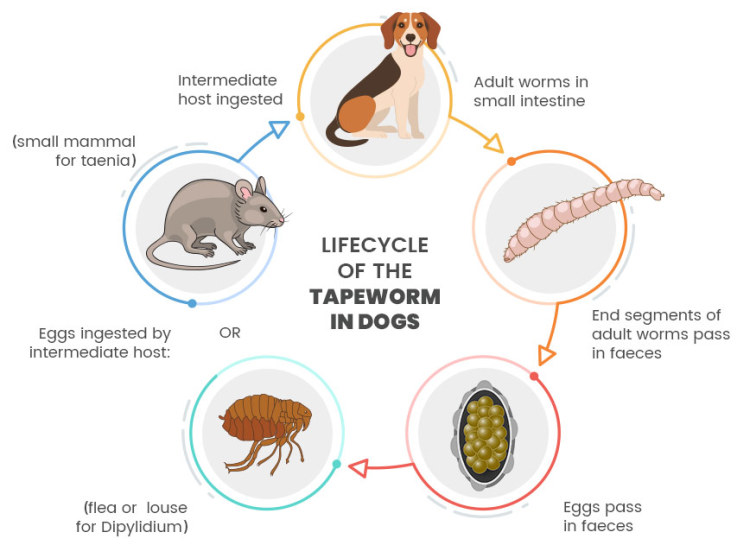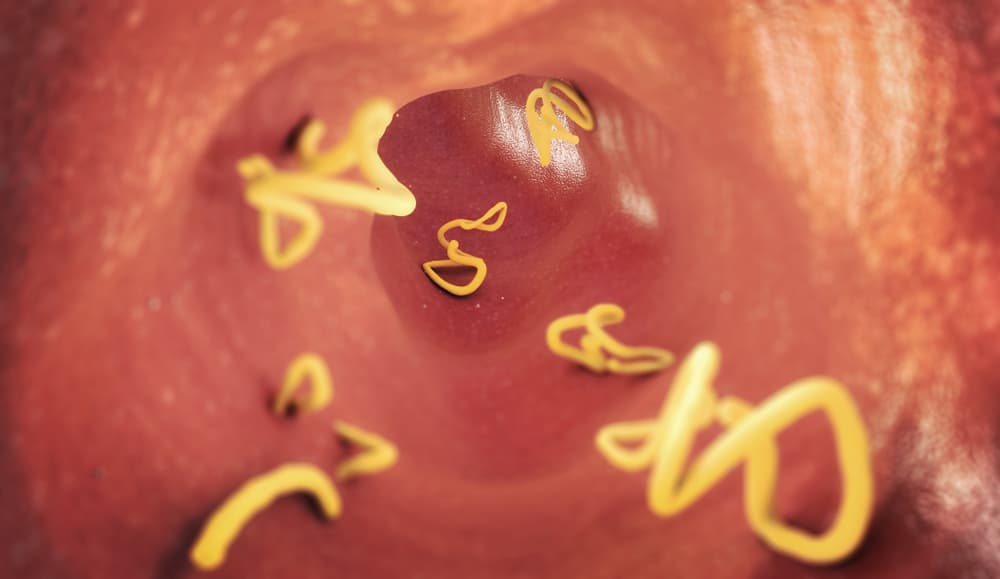Tapeworms are tiny parasites that live in your dog's gut. They’re often hard to detect and can cause a number of health issues, including vomiting and weight loss. Luckily, tapeworm infections in canines are not usually considered life-threatening.
This guide will help you detect the symptoms of tapeworm and make sure your pet gets appropriate treatment before they become a serious problem.
Pro tip: If you insure your pet from just eight weeks old, any treatment they might require for contracting parasites like tapeworms can be covered by your pet insurance policy.
Table of Contents:
- What are tapeworms?
- Can humans get tapeworms?
- What are the symptoms of tapeworms in dogs?
- How do you treat a dog with tapeworms?
- Can you prevent tapeworms in dogs?
- Key Takeaways
What are tapeworms?
Tapeworms are a type of intestinal parasite that affects dogs. They are typically flat, with small segments (proglottids) resembling a grain of rice. There are several tapeworm species that can affect canines, including Echinococcus, Taenia, Metacestoides, and the most common, Dipylidium caninum.
The tapeworm infection starts when the dog ingests a host harboring tapeworm eggs. This can happen during grooming or in response to a flea bite. The most common hosts are adult fleas, but other animals, such as rodents, rabbits, and birds, can also transmit tapeworm eggs to dogs.
The larvae are then released into the pup’s intestine where they mature. As the adult tapeworm continues to grow, the segmented packets that make up its body will break off and exit the intestine with the stool or attach to the dog’s fur around the tail and hindquarters.
 (Image source: Animigo)
(Image source: Animigo)
Can humans get tapeworms?
The risk of humans getting tapeworms from a dog is minimal because you’d have to swallow an infected flea. However, kids are at a higher risk, especially in environments with heavy flea infestations in the yard or home, or where good personal hygiene isn’t practiced, but this infection is not very serious.
Some tapeworms that infect dogs, for instance, the Hydatid tapeworm, can also cause disease in humans. Dogs can become infected with this type of tapeworm when they eat offal, or organs from infected animals). To stay on the safe side, avoid feeding offal to your canine companion and treat them regularly with an allwormer in order to decrease this risk in Hydatid tapeworm areas (in consultation with your veterinarian). Also try to keep them away from dead animal carcasses.
Humans can also get other types of tapeworms not associated with our pets. This can occur when they consume undercooked meat from an infected animal (fish, beef, and pork are the main carriers). Humans might not show any symptoms until years after ingestion. The best prevention of tapeworm infection in humans involves avoiding partially cooked or undercooked meat or meat by-products.
What are the symptoms of tapeworms in dogs?
Unfortunately, there aren’t many obvious signs of tapeworm infection in dogs. On the flip side, of all the parasites your four-legged companion can get, the tapeworm is one of the easiest to identify and treat. Most often, you will notice your furry friend biting or licking their anus or dragging the anus along the ground (scooting).
As this happens when the tapeworm segments (proglottids) break away and exit through the anal opening, you might also be able to see what looks like small pieces of rice or sesame seeds “wiggling” in your pup’s feces or around their anus. After they dry out, they might look like dried rice grains attached to the fur under the tail or around their anus. Eventually, the proglottids will break open, releasing the eggs into the environment. A single proglottid can contain as many as twenty tapeworm eggs.
If your four-legged companion is heavily infected, they may experience weight loss or even start vomiting whole tapeworms or portions of them (an adult tapeworm can be 4-28 inches long).
Tapeworm can be more serious in young puppies, making it difficult for them to put on weight as they grow by absorbing nutrients through their skin. They may also present problems for malnourished or neglected dogs, senior dogs, and dogs with weakened immune systems.
How do you treat a dog with tapeworms?
In order to confirm the presence of tapeworms, your vet will ask you to collect and bring a stool sample. The test will also determine if tapeworms are in the feces or in the anal sac. Occasionally, your vet might need more than one stool sample because tapeworm segments and eggs aren’t always passed every time your pet poops. Owners seeing the “rice shaped “ proglottid can be one of the best ways to diagnose tapeworms.
Canine tapeworms can be treated with praziquantel, an antiparasitic drug that’s available in both injectable and oral form. The drug clears the infection by paralyzing the tapeworms, causing them to detach from the intestinal wall, and then pass out of the body with a bowel movement.
Praziquantel does not commonly come with any significant side effects, but they might include diarrhea, vomiting, loss of appetite, and lethargy.
The drug is available in both OTC and prescription preparations. As with all medications, be sure to consult your vet in order to determine the proper dosage before administering drugs at home.
Other effective medications include tablets, chewables, and granules that are sprinkled on food. There are also combination medications that treat hookworm, tapeworm, whipworm, and roundworm in one. It is very important to administer all of the prescribed medications in order to make sure that the tapeworms are completely eliminated from your pet’s body.
Make sure to tell your vet about any supplements or medications your canine companion is taking so that your vet can make the best treatment decision for your dog and help minimize the risk of a potential drug interaction.
Pro tip: Pets are exposed to parasites year-round. Pet insurance can give you peace of mind as it covers some or all of the treatment costs if your dog suffers a sudden illness or gets involved in an accident.
Can you prevent tapeworms in dogs?
The good news is, preventing tapeworms in dogs is very easy. Here's how you can make sure your pet remains free of parasites:
-
Use flea and tick prevention products. Regular use of these treatments is the best way to prevent tapeworm infestation in your companion. There’s a number of effective products available over-the-counter or by prescription, in oral and topical form. Ask your vet for a recommendation.
-
Practice good personal hygiene by washing your hands regularly and teach children to wash their hands after playing with animals to reduce the risk of tapeworm transmission to humans and pets.
-
Always pick up your dog’s feces, especially in public parks and playgrounds, in order to minimize the chances for the tapeworm life cycle to continue in the soil.
Key Takeaways
- Dogs get tapeworms by eating fleas or small animals that carry tapeworm eggs.
- Although unpleasant and itchy, most tapeworms don’t produce obvious symptoms in canines other than worm segments present in their feces or on their behind.
- Flea and tick medication can help prevent tapeworms in dogs, as well as good hygiene habits.
- If you suspect your dog has tapeworms, call your vet to get an accurate diagnosis and effective treatment plan.
